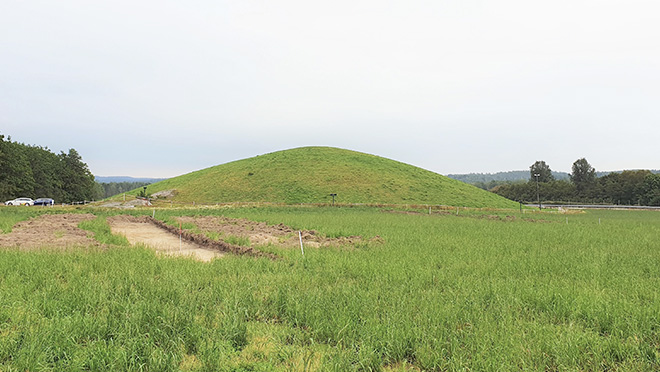The monumental Jellhaugen Mound dominates the landscape with its location beside the E6 highway near Halden, where it has stood since it was built in the migration period (400-550 AD). The mound was probably built in the 6th century, about 300 years before the burial of the Gjellestad ship. Through geophysical surveys, test tunnels and metal detecting, archaeologists know a lot about what other activities have taken place at Gjellestad in prehistoric times.
Long history
There is no doubt that Gjellestad has been a place of special importance. Since 2015, a number of discoveries of prehistoric objects have been made through metal detecting. In 2017, the (then) Østfold County Council conducted a survey and uncovered traces of four burial mounds destroyed by ploughing as well as packing stones interpreted as a grave. Several post holes and a fireplace were also uncovered. Georadar surveys in 2018 and 2019 revealed the ship burial, but also the remains of 15 burial mounds destroyed by ploughing, and post holes from at least five houses. Datings from the 2019 test surveys showed that the oldest traces of human activity at the site dates back to the Bronze Age (1800-500 BC), while the majority of the post holes are from the migration period. This suggests that activity at the site was particularly high at the time when the Jellhaugen Mound was built.
Holy place
After the migration period, it seems that the settlement on the land was abandoned, and the site developed more like a sacred place with a large collection of burial mounds. So far, the Gjellestad ship is the only known construction that can be dated back to the Viking Age, but there are metal detector finds of parts of two similar buckles, the end knob of a ring buckle, a dirhem (Arabic coin) and a weight, which are also evidence of activity during the Viking Age.
Power and status
When the Gjellestad ship was buried sometime between the late 8th and early 10th centuries, it was customary to associate oneself with an already established power symbol in the landscape. By using the same burial site the chieftains associated themselves with the power of the surroundings. Like the ship burial from Borre and the large mounds in the same burial ground, Gjellestad is also located in an older landscape with monumental burial mounds and large hall buildings. There are strong indications that Gjellestad, like Gokstad, also included an important trading post just a few hundred metres away from the ship burial. On Hjelmungen farm, on the south side of the E6, a number of weights and other objects have been found that can be linked to trade and production on the site. The concentration of discoveries is also close to where the shoreline was in the Viking Age. As a whole, the Gjellestad complex has the potential to become one of the best preserved chieftain sites from the Viking Age in Norway.
